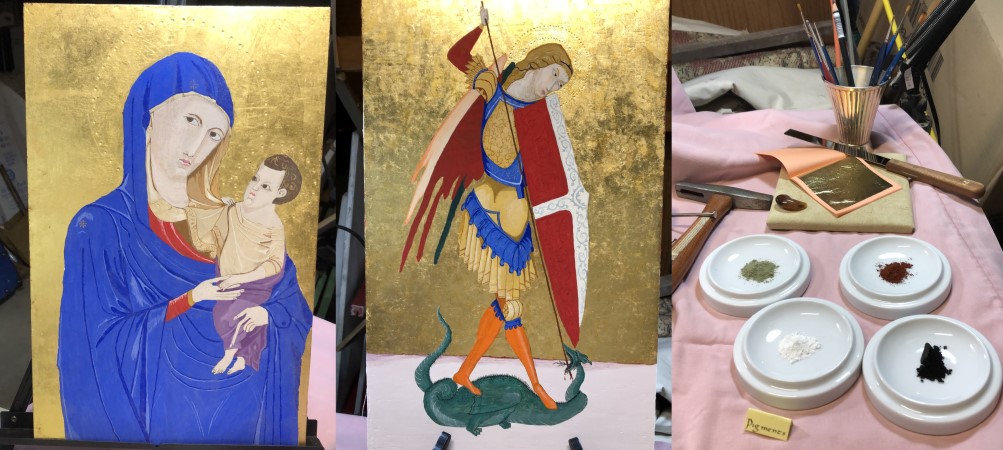East Kingdom Wiki: https://wiki.eastkingdom.org/index.php?title=Jan_Janowicz_Bogdanski
Introduction
These are paintings on a wooden panel inspired by various 13th and 14th century examples. These figures are executed using egg tempera and show influences of both Eastern and Western Gothic painting styles of the time.
What is Italo-Byzantine Style?
It is the shapes of the various forms that define the Byzantine icon style. The human form is not meant to mirror real life, but is a representation of spiritual life, thus the figures are stylized deliberately. The icon is to make the viewer think of the spiritual, not the physical.
This style has a very narrow window. Practiced most famously in Siena and Florence, with known works in Venice and Sicily as well, it reached its height with artists such as Cimabue, whose last piece was still in process when he died in 1302, and Guido da Siena, whose works date from the 1270s. Cimabue’s renowned student Giotto was the first great artist of the proto-Renaissance style, which was the next one in the evolution.
What am I looking at?
I have two pieces seen above: the main piece is one of St. Michael the Archangel battling the serpent, with a supporting piece of the Madonna and Child.

It always makes me happy to see another iconographer. It dominated Mediterranean art during this period, and egg tempera just doesn’t get the love it should in the SCA.
If you ever have any questions, feel free to connect!
Agreed about the egg tempera – trying to change that one painting at a time. 🙂
Thank-you
These are so beautiful! I love the information presented in the video.
Thank-you!
This is gorgeous! And the video is wonderful, thank you so much for sharing!
Thank-you!
My Norman Siclian persona loves this. Thank you.
There are some outstanding examples of Christ Pantocrator in the domes of Sicilian cathedrals that I have used as inspiration.
Wow, this is awesome. I don’t know much about painting or iconography, so it was cool to learn about it in a short, enjoyable format!
Thank-you!
Gorgeous work!
Thank-you!
Stunning! Thank you for such beautiful work and the fine historical lesson that accompanied it.
Thank-you!
I enjoyed following your progress on these painting on FB. It is wonderful to learn more about the materials you used. I do not know that much about painting, I am wondering how you liked working on this medium compared with the others you have worked on? These are both gorgeous!
Vivian, it is VERY different from gouache, which is my standard paint for document work. I find egg tempera extremely challenging, but also very satisfying. The ability to layer color is just – for lack of a better word – cool and it allows me to do things that I can’t do in gouache. Sure, I also can’t blend adjacent colors in tempera but that’s just another technique for me to practice and get better at.
This is amazing! I’ve been starting to get into egg tempera painting, it’s really really great to see such a well made finished piece! So far it’s the non-paint parts that are intimidating (the wood panel, the gesso, gilding), so I really appreciated seeing your explanations.
Philippa, CA127 “Techniques of Medieval and Renaissance Painting” is a fantastic resource.
Really beautiful work. Thank you so much for bringing us into your materials with the video. Double bonus – I learned about a new thing. 🙂
Thank-you. I’m glad you enjoyed it (and I’ll let my “cinematographer” know that you liked the video 🙂 )
Wonderful!
Thank-you!
Well done. This is fascinating to see how these mediums were used to create Art. Thank you.
Thank-you, Your Majesty!
Whoa! Gorgeous. Love the gold work!
Thank-you!
Wow! This is really nicely done. The video was also a great explanation.
Thank-you! Glad the video was helpful.
Beautiful work! And thank you for a great video introduction – I appreciated knowing more about the process, history, and challenges of this art!
Thank-you! I’m glad you found it helpful.
Very cool to see the period materials and techniques! I appreciate the video, too — it was really interesting to see how the pieces came together. They turned out beautifully!
Thank-you!
I have been admiring your progress with this technique for years. Each piece is beautiful and I could see them adorning a church.
Beautiful work!! Thank you for sharing!!